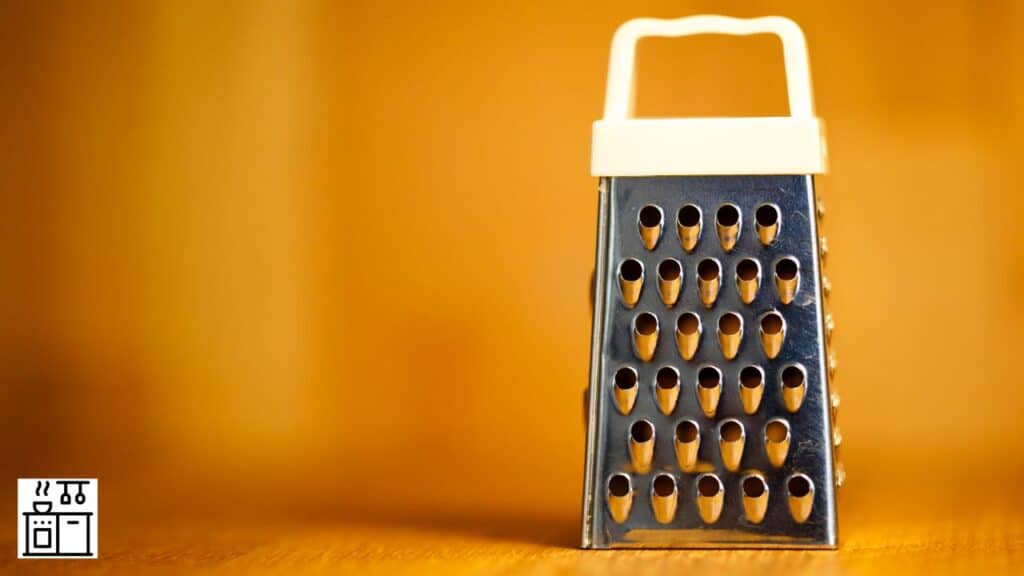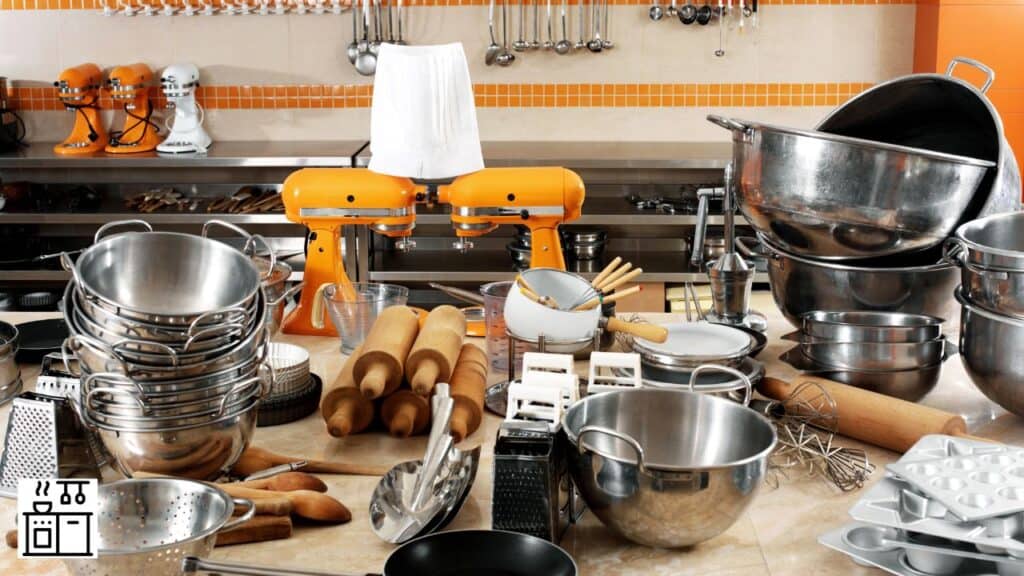Kitchen utensils are an integral part of cooking. There are multiple varieties to serve different purposes.
Over time, the number of kitchen utensils has increased significantly.
Let’s look at the different kitchen utensils that every enthusiastic cook should be aware of, and include in their collection.
- 1. Pans
- 2. Dutch Oven
- 3. Pressure Cooker
- 4. Instant Pot
- 5. Casseroles
- 6. Stock Pot
- 7. Soup Pot
- 8. Knives
- 9. Cooking Thermometers
- 10. Tongs
- 11. Strainers
- 12. Graters
- 13. Bowls
- 14. Griddle
- 15. Double Boiler
- 16. Baking Dishes
- 17. Colander
- 18. Chopping Board
- 19. Garlic Press
- 20. Egg Slicer
- 21. Vegetable Peeler
- 22. Measuring Spoons
1. Pans
The term “pan” is a generic term that refers to a variety of cooking utensils with a flat bottom and raised edges.
So, there are different types of pans, each better suited for a different purpose than the other.
Here are some of the most popular types of pans.
Frying Pans
A frying pan is also called a skillet. It has a flat bottom and slightly raised sides.
Frying pans are used to deep fry, shallow fry, and sear food. They can also be used for browning food, toasting bread, and other tasks.
Woks or Stir-Fry Pans
Though woks work like frying pans, they look different. In this case, the pan has a smaller rounded base and raised sides.
This makes it easy to stir ingredients. Woks are widely used in Chinese and Asian cuisines to stir fry ingredients like vegetables, meat, or rice.
Grill Pan
A grill pan resembles a frying pan, but it has ridges on the surface.
Ingredients cooked in a grill pan develop distinctive grill marks, that add color and texture to a dish.
Saucepan
A saucepan is a deep pan with raised edges and a long handle. It can easily hold liquids for cooking.
So they are typically used to make sauces, soups, stews, and other liquid-based dishes.
Roasting Pan
A roasting pan is a deep pan that goes in an oven. You can use it to cook ingredients at a high temperature for a long time.
Most roasting pans come with an internal rack that allows the liquid from the meat or vegetables to drip down.
Non-Stick Pan
Non-stick pans may be made of carbon steel or cast iron that has natural non-stick properties.
Alternatively, it may also have a non-stick coating like PTFE or Teflon.
Food doesn’t stick to the surface of these pans, but it glides and moves around the surface easily.
Sauté Pan
Sauté pans are shallower than regular frying pans. They look like skillets with straight sides.
This pan is typically used to brown meat or prepare vegetables for a casserole or stew.
Muffin Pans
As the name suggests, muffin pans are specially designed to make muffins.
They have holes or depressions into which you can place muffin liners and add muffin batter.
2. Dutch Oven
A Dutch oven is a heavy pot with a thick base and a heavy lid. You can use it for various purposes in the kitchen.
The structure and shape of the pot make it work like an oven, but you can use it on the stovetop.
You can use a Dutch oven for braising, making stews, soups, and casseroles.
Dutch ovens can go from the stove to the oven and back. Hence, it’s a versatile cooking utensil.
3. Pressure Cooker
A pressure cooker uses high pressure to cook food quickly.
The design of this utensil is such that pressure builds up inside the compartment using heat from the stove.
The food cooks quickly in this steam, reducing the overall cooking time.
Pressure cookers can be used to make a variety of recipes using different ingredients.
Both stovetop and electrical versions are available.
Pressure cookers may also have multiple functions like slow cooking, steaming, and sauteing.
4. Instant Pot
An instant pot is a multicooker with various functions like pressure cooking, slow cooking, steaming, and heating.
You can even use some instant pots to make cakes. It’s a standalone device with a deep pot and a tight lid.
It uses the principle of pressure cooking to prepare food.
5. Casseroles
A casserole is a deep dish that can be used in an oven for baking or on the stovetop for regular cooking.
It’s wide and holds a large amount of ingredients. So, you can use the casserole dish to make a single item or a layered dish like a lasagna.
6. Stock Pot
A stock pot is a wide pot with a flat bottom. It’s deep and can hold a large quantity of liquid.
As the name suggests, stock pots are typically used to make vegetable or meat-based stock or broth.
These pots have two handles on the sides, and they come with a lid.
They are typically made of heavy metal alloys like stainless steel or iron. But you can also find stock pots made of terracotta or clay.
7. Soup Pot
A soup pot resembles a stock pot with a round base, deep straight edges, and a cover. But it has a thick base.
Stock pots are usually lighter and thinner than soup pots.
Though soup pots are typically used for making soups, you can also cook pasta and vegetables in them.
8. Knives
Knives are an essential tool for any chef. They come in a variety of shapes, sizes, and designs for different needs.
Depending on the shape and purpose, you can divide knives into the following:
- Fillet Knives and Boning Knives: To fillet and debone meat and fish neatly.
- Chef’s Knife: A multipurpose knife that serves a variety of functions.
- Bread Knife: This knife has a serrated edge to easily cut bread, but it can be used for other purposes too.
- Paring Knife: It’s smaller than a chef’s knife with a similar shape used for peeling and cutting fruits and vegetables.
- Shun Knife: A versatile knife that originated in Japan. Traditional Samurai knife-making techniques are used to develop the blade.
- Cheese Knife: There are different types of cheese knives to cut various types of cheese, like pronged knives, soft cheese knives, cheese spreaders, and flat cheese knives.
9. Cooking Thermometers
Cooking thermometers can ensure that the food is properly cooked.
You can use cooking thermometers to check whether meat and other ingredients are thoroughly cooked.
Modern cooking thermometers have digital displays, but the traditional versions have analog displays.
10. Tongs
Tongs are an essential kitchen utensil to pick and move hot food or coals. It consists of two metallic or wooden arms connected at one end.
You can use it to lift hot items and flip them. Tongs are also useful for heating food on the stove without burning your fingers.
11. Strainers
A strainer is a device with a mesh or sieve to separate liquids from solids. The ingredient to be separated will be poured into a strainer.
This utensil holds the thicker or more solid part while allowing the liquid to flow through.
Strainers are commonly used to separate whey or tea leaves from tea.
12. Graters

A grater is a device with a base or side with holes. These holes have slightly raised edges that allow you to grate soft or semi-soft items like cheese.
You can also grate vegetables like carrots and beetroots using a grater.
The holes on a grater come in different sizes that yield gratings of different sizes. Graters can either be flat or standing models.
13. Bowls
Any kitchen utensil used to hold food can be called a bowl. You can also use some bowls for cooking.
They have a spherical shape with a flat or round base and a hollow interior portion.
Bowls can be made of metal, ceramic, clay, wood, or other materials. They can be used to hold food or ingredients like salads and soups.
14. Griddle
A griddle is a flat-bottom heavy iron dish with raised ridges in the base. It’s heated and used for cooking food. Griddles can go on the stovetop.
Alternatively, electric griddles are standalone kitchen devices that work on electricity.
The unique square shape makes it useful to cook a variety of ingredients.
Griddles are typically used to cook meat, vegetables, kebabs, and hot dogs. This utensil imparts a characteristic smoky flavor to the food cooked in it.
15. Double Boiler
A double boiler has two pots in such a way that one sits inside the other without touching the base.
Water is added to the lower pot and boiled, while the cooking ingredient is added to the pot on the top.
The steam from the water in the base pot will gently cook the ingredients in the other pot.
The main advantage of the double boiler is that it allows gentle and uniform cooking of food.
It’s typically used for cooking ingredients like egg-based sauces and melting chocolate.
16. Baking Dishes
Baking dishes come in all sizes and shapes and are made of heat-resistant material. They tolerate high oven temperatures.
Some materials used to make baking dishes are iron, carbon steel, aluminum, ceramic, and terracotta.
Depending on the dimensions, baking dishes can be used for a variety of needs like baking, roasting, grilling, and broiling.
17. Colander
A colander is a perforated dish with holes in the base. It’s used for washing ingredients like rice or vegetables.
The main advantage of a colander is that the water passes through the holes in the base after washing. Colanders can be made of metal or plastic.
18. Chopping Board
As the name suggests, a chopping board is a surface used to cut vegetables, fruits, or meat.
They can be made of metal, wood, plastic, rubber, or bamboo. It can come in all shapes and is usually rectangular or round.
19. Garlic Press
A garlic press is a specialized device used to crush garlic. It has a barrel-like insert where you place the garlic.
You can then press the lever on the side to crush the whole garlic pod and release the crushed garlic without the pod.
20. Egg Slicer
An egg slicer is a gadget with a string of cutting wires that makes it easy to cut a whole boiled egg into thin slices.
To use it, place the boiled egg on the perforated base and gently press down the cutting wire section.
This will chop the egg into fine slices. You can use an egg slicer to cut other ingredients like strawberries and mushrooms too.
21. Vegetable Peeler
A vegetable peeler can peel vegetables and fruits. You can use it to remove their outer skin.
These devices look like knives, with a flattened blade and a hole in the center to remove the peel.
22. Measuring Spoons
Measuring spoons are used to measure different ingredients accurately. They usually come with a set with indications on the handle or base.
Measuring spoons will make it easy to measure ingredients ranging from ¼ teaspoon to 1 cup. They may be made of metal or plastic.

